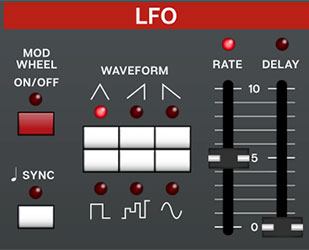
The low-frequency oscillator (LFO) generates sub-audio range signals intended for modulation purposes.
Mod Wheel Switch- This is a really handy, but potentially confusing feature, so don’t skim this section. If the switch is in the Off position, the LFO is always “on.” Its effects will be immediately audible by moving the LFO sliders in the DCO, VCF, and VCA sections. Clicking to the On position enables control of LFO depth with an external keyboard controller mod wheel. If the mod wheel is all the way down, LFO depth is zero. This makes setting up a mod wheel to add vibrato or wah effects very easy. If it seems like the LFO isn't working, check if the Mod Wheel switch is engaged.
Waveform- Selects the repeating pattern of the LFO. Available waveforms are triangle, ramp, sawtooth, square, random, and sine waves. Only one waveform is available at any time.
Rate- Sets the LFO rate from 0.1 to 30 Hz with Sync disabled (i.e. free-run mode).
Sync- Engaging the Sync button locks the LFO master tempo. When engaged, the Rate slider snaps to note values ranging from 1/64th note triplet to 8 beats. Sync mode locks to the tempo in the top toolbar when using the DCO-106 standalone version or the current project tempo when the plug-in version is used in a DAW.
Delay- Moving this slider up gradually delays the onset of LFO depth. The delay time can be set from 0 to 5 seconds. Because DCO-106 includes separate LFO’s for each polyphonic voice, onset delay is independent for each note, which is a nice effect when playing melodies or arpeggiated note passages. The LED above the slider gradually illuminates to visually indicate the fade; the LFO is at full intensity when the LED is fully illuminated.
When the Mod Wheel switch is in the on position, the Delay slider grays out and is disabled (because you wouldn’t want the onset of LFO mod delayed when controlling mod amount with a mod wheel).